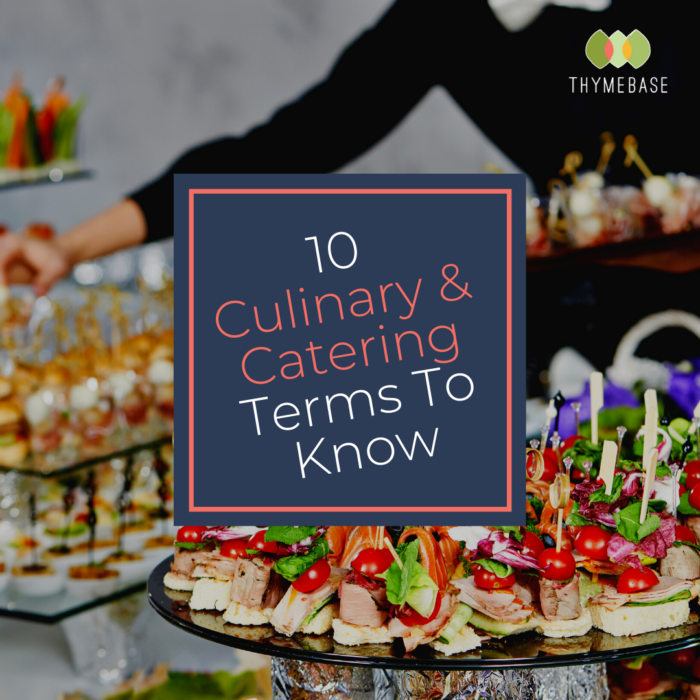It’s essential to learn the standard culinary and catering terms you’re bound to see in the event planning world. The event planning industry is riddled with confusing jargon, but the realm of F&B is another world. French terms rule the culinary arts, and caterers might as well have their own dictionary.
Here are 10 culinary and catering terms – just an amuse-bouche (bite-sized appetizer), to satisfy your culinary term palate. Foodie or not, here we come!
1. A la carte
Let’s start with an easy one. A la carte is when every menu item is priced and served individually. This is the opposite of a fixed menu where multiple courses are served at one fixed price. A la carte offerings are great at events because they allow complete flexibility. Just don’t mix it up with the term a la mode – or a dessert topped with ice cream!
2. Deadstock
Leftover wine? No way that’s real! But seriously, deadstock (leftover wine and liquor ordered for an event) is a problem in the F&B industry. Since liquor and wine are often ordered by the crate, a surplus of the stuff can create problems for the venue storage-wise and financially for the planner.
To get rid of the deadstock, create drink specials with the leftovers. Or try to use the supply at another event. Or even talk to your liquor rep! With a good relationship, you may be able to wrangle a bottle exchange or buy-back.
3. Silencer
It sounds ominous, but a silencer does precisely what the name suggests: silences. A silencer refers to the padding hidden underneath a tablecloth used to damper the clatter of dishes, cups, and cutlery. Silencers are especially crucial if you have presentations or speakers during the meal. There’s nothing like the annoying clanking of silverware to distract your speaker!
4. Banquet Setup
A banquet setup is when the room is filled with banquet rounds or large round tables. Banquet setups are often used for meals without entertainment or a speaker since guests are seated around the large round tables. Thus they’re all facing different directions. Banquet rounds are an efficient use of space since every part of the table could become a potential seat versus rectangle shapes. Common sizes include 48″ for six seats, 60″ for eight, and 72″ for 10-12 guests.
5. Cabaret Setup
On the other hand, you have a cabaret setup. This is when every guest is situated to face the front of the room – like if you were watching a cabaret. Cabaret setups are ideal for speakers, presentations, or entertainment. Rather than long, skinny rectangle tables you may see in a workshop environment, cabaret setups typically use small tables. Usually, they sit two to five guests.
Read More: How A Top Event Planner Selects Vendors
6. Banquet Service Charge
A banquet service charge is a fee to cover the operational expenses for a catering business. This is not the tip, but rather an operating cost. Service charges vary drastically from company to venue to location ranging from a typical 18% to as high as 49%! It’s vital to know whether the banquet service charge is included in a caterer’s proposal or not. This fee is also a great way to compare competing proposals.
See, knowing culinary and catering terms can pay off in negotiations.
7. Out Mess
While it sounds a bit messy, an out mess is a meal given to the event team and workers meant to be eaten in the back of the house (out of sight). The front of the house refers to everything that event-goers see, while the back of the house is where all the magic (and apparently employee eating) happens.
8. Family Style vs. Food Stations
Family style is the service where large platters are put in the middle of the table, and guests help themselves. Food stations refer to small, staffed tables scatter the dining room, each featuring different parts of the menu.
9. French Service vs. Plated Service
Leave it to the French to be extra. French service is the service where food preparation happens live table-side and used for guest entertainment. Today it’s common with dishes like guacamole, flambe, and meat carving. Plated service is when the chef does the work, and the food is arranged on the plate in the kitchen.
10. Aperitif vs. Digestif
To round off our culinary list, we have two fun terms. An aperitif is a light cocktail served prior to dinner. It’s designed to stimulate the palate and prep the drinker for the upcoming meal. After dinner is done, you’ll see a digestif. This light cocktail is meant to aid in digestion.
Amanda Larson, CED, is a Certified Event Designer, marketer, and content creator. With a degree in journalism and special events management, Amanda has worked in marketing and events for both international startups and Fortune500 companies. She specializes in digital branding, copywriting, and graphic design freelancing for clients globally.
You can read other articles by Amanda here:


Pingback: The Top 5 Wedding Industry Trendsetters - Blog